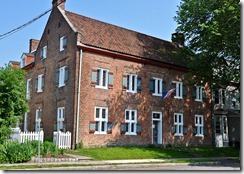Nestled in the heart of the Hudson River Valley in Rensselaer, NY, the Crailo State Historic Site is a remarkable treasure trove of history. This intriguing site, once part of the expansive Van Rensselaer estate, is a testament to the enduring influence of the Dutch in the Hudson River Valley.
One of the most enduring and patriotic children’s songs, Yankee Doodle, was written in Rensselaer County at the birth of our nation, but it did not start out as a song for children. It didn’t even start out as complimentary of our country.
As the story goes, Dr. Richard Shuckburgh, a British army physician, wrote “Yankee Doodle” after “witnessing the sloppy drill and appearance of Connecticut troops” while at Fort Crailo in Rensselaer.
Built in 1704 by Hendrick Van Rensselaer in an area then known as “Greenen Bosch”—”Pine Forest” in Dutch and later corrupted to “Green Bush,” Fort Crailo was never truly a fort so much as a fortified manor home.
From the exterior, you would never guess that this lovely house, facing a park on the banks of the Hudson River, is built for battle; yet two of the eleven original gun ports used for defense against an attack by a French and Indian war party in 1746 can still be seen on visits to this historic site.
Fort Crailo is full of surprises, not least of which are the engaging, world-class exhibits.
Table of Contents
A Visit To Crailo State Historic Site
On a visit with 12-year-old Alex, we were greeted by Anya Lee, a doctoral candidate in history, who brought great enthusiasm and insight to descriptions of Dutch colonial culture.
The one-hour tour opened with the arrival of the Dutch in New Amsterdam and quickly veered to tales of piracy, and other spine-tingling adventures. Having captured our imagination, Anya led us to hands-on displays where we could see and touch replicas of colonial artifacts – lots of Dutch pipes! – found on archeological digs in Albany’s Fort Orange excavations.
In another room, we watched the award-winning short film, “Keeping Order: A Fort Orange Court Record,” which combines a 350-year-old court record with “The Quarrel,” a 17th-century Dutch painting. Starting as a frozen picture on a wall, the painting comes to life as actors reenact court hearings to settle a card game brawl.
Upstairs, restoration has opened up a room fully decorated in period style. Here, Anya explained the odd three-legged chairs and the role of Delft tiles in colonial homes. Not that my son paid much attention; he had crawled into the bed, a curtained hidey-hole that is as warm and welcoming now as it was in the 1700s.
Our visit was brief but interesting; my only regret was that I had not arranged to attend the hearthside cooking demonstration. That was a lot of fun on a prior visit with my Girl Scout troop, and I’m told, not much has changed.
The cooking demonstration is a one-hour program, usually following the tour, which starts with an introduction to colonial ingredients followed by the participants taking turns to help make Seed Cakes, a caraway sugar cookie whose recipe dates back to a contemporary neighbor of the Van Rensselaer family.
The History of the Crailo State Historic Site
Built in the 17th century, the Crailo State Historic Site is an outstanding example of Federal-style architecture. The mansion was originally constructed as part of the vast estate owned by Kiliaen Van Rensselaer, one of the original Dutch patroons who established colonies in the United States in the 1600s.
The name ‘Crailo’ comes from the Van Rensselaer family estate in the Netherlands, and it means ‘Crows Wood’ in Dutch. Over time, the building underwent several transformations and expansions, with the most significant alterations occurring in the 18th century, reflecting the architectural shift from the Dutch Colonial to the Federal style.
A Peek into Dutch Colonial Life
Today, Crailo serves as the Museum of the Colonial Dutch, providing visitors with an immersive exploration of the 17th and 18th-century Dutch colonial experience in the Hudson River Valley. Through various exhibits, artifacts, and interpretive programs, the museum provides a wealth of information about the history, culture, and lives of the early Dutch settlers who played a pivotal role in the formation of what would eventually become New York State.
The museum houses a variety of fascinating exhibits, from furnishings and artifacts of the period to interpretive displays about the Dutch trade and farming practices. This journey into the past allows visitors to gain a deep appreciation for the Dutch settlers’ contribution to the early United States’ culture and economy.
Experience the Past
Visiting the Crailo State Historic Site is much more than just a field trip to a museum; it’s a journey into the early days of the United States, a period when New York was New Netherlands, and Dutch was the dominant culture. As you explore the rooms of this historic mansion and the artifacts within, you’ll find yourself transported back to a time that laid the foundation for the modern Hudson River Valley.
Immersing oneself in this well-preserved site helps to better understand the legacy of the early Dutch settlers. It showcases how their influence shaped the Hudson River Valley and, in broader terms, contributed significantly to the culture and history of New York State and the United States.
The Crailo State Historic Site, steeped in history and rich in Dutch colonial heritage, is a must-visit for history buffs, students, and anyone interested in understanding the area’s early settlement. Step into the past, walk the halls of the grand Van Rensselaer estate, and relive the fascinating history of the Dutch in the Hudson River Valley.
Plan A Visit To The Crailo State Historic Site
Crailo State Historic Site can be visited year-round by appointment and walk ins are welcome during regular tour hours mid-May-October. A schedule of upcoming special events can be found online on the NY State Parks’ page for Crailo State Historic Site.

